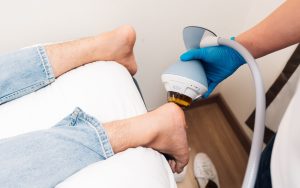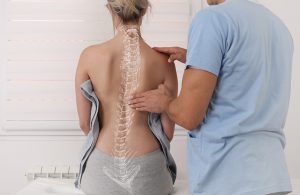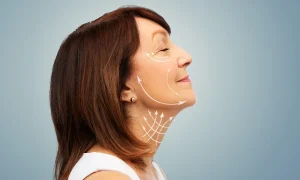If you are struggling with an eating disorder you may have heard about body neutrality and wonder whether it could be helpful for your recovery.
This article will discuss what body neutrality is, how it represents a shift from a focus on body positivity, and how you can work on building body neutrality.
Eating Disorders and Body Image
Not everyone with an eating disorder struggles with a negative body image, but negative body image can be a significant problem for many with eating disorders. It is a defining feature of several eating disorders.
For example, anorexia nervosa includes a “disturbance in the way one’s body weight or shape is experienced, undue influence of body shape and weight on self-evaluation, or persistent lack of recognition of the seriousness of the current low body weight.”
In bulimia nervosa, “self-evaluation is unduly influenced by body shape and weight.” Even putting eating disorders aside, our cultural climate defines thinness as a virtue and a way to attain status—a negative body image is commonplace among people who have not been diagnosed with a disorder.
In a 1984 paper, “Women and weight: A normative discontent,” Rodin, Silberstein, and Striegel-Moore coined the term “normative discontent” to describe women’s dissatisfaction with their weight and preoccupation with their appearance, which had become so prevalent it was considered the norm.
A 2013 study confirmed that body image dissatisfaction is a problem impacting people of all genders, not just women.
And in cases of gender dysphoria—the distress associated with feeling that one’s body does not match the gender with which one identifies—body dissatisfaction is a common and intertwined issue. Disproportionately higher rates of disordered eating behaviors are found among people who identify as transgender or gender non-conforming.
What Is Body Neutrality and Is It a More Realistic Goal than Body Positivity?
Body neutrality is a concept that has been discussed in popular media since about 2015 but there are only a few formal studies. Body neutrality refers to a potentially more realistic recovery goal than full body acceptance, body positivity, or body love, which have previously been suggested as goals for successful eating disorder recovery.
Body dissatisfaction is a normal state among people without eating disorders. How, then, can we realistically expect people with eating disorders in recovery to attain full body positivity—winding up with even less body image dissatisfaction than the population at large?
While there’s certainly nothing wrong with body love, if we hold it up as an end goal for recovery, we risk making recovery seem out of reach for most people, including those who have experienced body hatred, trauma, stigma, and gender dysphoria. Body positivity implies unconditional acceptance without room for any other experience of the body.
The ideal of body love is also an absolute: implying that, after recovery, one should love one’s body all the time. In Eating Disorder Treatment Therapy, we aim to challenge this sort of black and white thinking; having an all-or-nothing definition of recovery would run counter to this goal.
Dietitians at NourishRX, a practice in Massachusetts, suggest a continuum starting from body hatred and passing through body neutrality, body appreciation, and body acceptance on its way to the ideal of body love. They posit that loving your body all day, every day “is just plain unrealistic given all the things our bodies go through with us.”
They suggest going from one extreme to the other can feel like a discouraging, unattainable goal. So, taking the smaller steps toward acceptance is more realistic and less daunting.
It’s OK and normal for any of us to have days where we don’t feel perfect in our bodies and days where we don’t love the way our body looks. In the words of Australian therapist Ashlee Bennett, AThR, “Not experiencing these things [body love] all the time doesn’t mean you’ve still got work to do—nope! Just like goals around happiness 100% of the time, our experiences in our bodies are varied, layered, paradoxical, multicoloured—trying to hold a single view or feeling about your body is an exhausting job and a bit of a cruel task.”
How to Work on Body Neutrality When You Have an Eating Disorder
We might feel at our worst when we compare ourselves to celebrities and other people who have the most idealized bodies in our culture. It can be helpful to remember the resources that go into helping them look the way they do: stylists, personal chefs, trainers, Photoshop, and so on.
Here are some ways you can incorporate body neutrality in your life.
Limit Exposure to Unrealistic Body Standards
You can reduce your exposure to unrealistic body standards by unfollowing people who promote unrealistic body standards and unhealthy behaviors.
Learn About Body Diversity
You can educate yourself about body diversity and expose yourself to more diverse bodies. Traditional media usually only portrays the most idealized bodies in the culture. When it exhibits bodies of more marginalized statuses, it usually displays them in a negative light, e.g., stock photos of disheveled people in larger bodies eating junk food.
You can curate a social media feed in which you deliberately follow accounts of people with diverse sizes, shapes, skin colors, and abilities. This can help to challenge the stereotypes that we all hold about bigger bodies.
Practice Body Gratitude
You can practice body gratitude by appreciating the skills, strengths, and capabilities of your body. Notice the things your body allows you to do and experience. Did your legs take you to where you needed to go today? Did your arms allow you to hug your loved one? Were you able to feel the beat of the music in your body when you danced? Answering these questions will help you show gratitude to your body.
It is also important to work toward accepting the fact that you don’t have to love your body all of the time. Acknowledge that unconditional body positivity is not realistic. Instead, working toward body neutrality is a more achievable goal.
Stay True to Your Values
You can remind yourself of your values and what you want to be known for. Do you want to be remembered as the skinniest, most fit, or most beautiful person? Or do you want to be remembered for being a caring person who focused their efforts to make the world a more positive place?
Take Care of Your Body
Focus on caring for your body—we are more likely to be able to appreciate something we take good care of. This includes eating intuitively regular satisfying meals, engaging in joyful movement, and getting enough rest.
People with eating disorders benefit from treatment by professionals including psychologists, therapists, dietitians, and medical doctors. You are encouraged to seek help and reach out to your team for help with your body image concerns.






More Stories
Shockwave for ED vs. Traditional treatments – A comprehensive comparison
Effective Ways to Manage Spinal Curvature in Adolescents
Enhance Your Culinary Experience: Pairing Cannabis Strains with Local Flavors